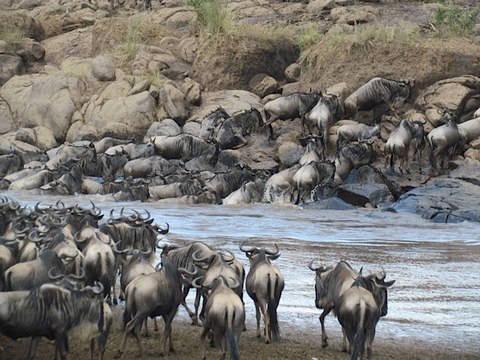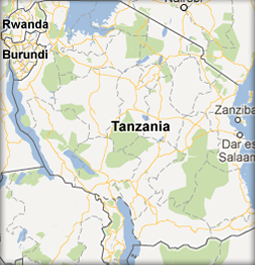
Most visitors to Tanzania are attracted by the opportunity to witness one of Nature’s most incredible phenomenons – the Great Migration. This is one of our planet’s most spectacular wildlife events and it can be seen on our Great Migration safari in Northern Tanzania and Kenya.
Here we have put together a guide to the movement of the Great Migration within Tanzania and which locations are best to view it according to the time of year, and which safari camps / lodges we would recommend.
The Great Migration is the largest and longest over-land migration and is one of the Wonders of the Natural World. Over 1.5 million wildebeest – and 200000 zebra and gazelle – move in vast herds in an unending 2000 kilometre cycle within the Serengeti and Maasai Mara ecosystems. Their constant quest for fresh grasses keeps them on this eternal journey of life, chasing the rains over this huge area of open plains and woodland and across obstacles such as fast-flowing rivers.
This profusion of plains game attracts predators such as hyenas and the Big Cats, so game-viewing is particularly rewarding.
Where to Stay
We offer a vast range of permanent or mobile camps and safari lodges in many locations across Tanzania to ensure that our guests are in the heart of the action, whatever time of year they choose for their Great Migration safari holiday.
The mobile tented camps offer an unrivalled wilderness experience and these are located close to the herds at any time of year. For those who prefer luxury over adventure, there are permanent lodges in superb locations for exhilarating game drives.
Below we have outlined the general cycle of the Great Migration, and some great camps and lodges (and tours) to consider according to the time of year. Please note that wildebeest and their exact travel plans are unpredictable, they have been known to take unexpected routes and to even turn back on themselves, but this can be used as a general guide.
December to March
This time of year sees the wildebeest gather around Lake Ndutu to the south of the Serengeti. Here, half a million calves are born and the herds are spread throughout the vast Ngorongoro Conservation Area. The UNESCO World Heritage Site and the Ngorongoro Crater are highlights of any visit to Tanzania, and visitors are rewarded with remarkable wildlife spectacles as well as interesting archaeological sites at “The Cradle of Mankind”.
Great choices of accommodation at this time include:
- Plantation Lodge
- Exploreans Ngorongoro Lodge
- Lemala Ndutu (Migration) Camp
- Lemala Ngorongoro Camp
- Ngorongoro Serena
- Ubuntu Safari Camp
- Olakira Camp (Ndutu)
Tours that include this area are:
- 3 night Manyara & Ngorongoro Safari
- 5 night Highlights of Tanzania
- 6 night Tanzania Discovery
- 4 night Serengeti Luxury Safari
- 9 night Kenya & Tanzania
- 6 night Luxury Northern Tanzania Flying Safari
- 8 night Tanzania Luxury Flying Safari
April to July
At the start of this period the wildebeest migrate northwards into the grassy plains of the Southern Serengeti . From late May the Migration herds tend to split, some heading West into the Western Corridor and crossing the Grumeti River – this is one of the best locations to witness the herds making a perilous river-crossing through crocodile infested waters. They then start arriving into the Kogatende area in July.
The other herds head directly up through Central Serengeti passing Seronera and on to the Bologonja River area near the Loliondo reserve.
Great choices of safari accommodation at this time include:
Western Corridor (Grumeti):
Central & Southern Serengeti:
Tours that include this area are:
- 5 night Highlights of Tanzania
- 6 night Tanzania Discovery
- 4 night Serengeti Luxury Safari
- 9 night Kenya & Tanzania
- 6 night Luxury Northern Tanzania Flying Safari
- 8 night Tanzania Luxury Flying Safari
August to November
Northern Serengeti:
- Kimondo Safari Camp
- Lemala Kuria Hills Lodge
- Lemala Mara Camp
- Sayari Safari Camp
- Olakira Camp (Mara)
- Serengeti Safari Camp
- Ubuntu Safari Camp
Tours that include this area are:
- 6 night Tanzania Discovery
- 4 night Serengeti Luxury Safari
- 9 night Kenya & Tanzania
- 6 night Luxury Northern Tanzania Flying Safari
- 8 night Tanzania Luxury Flying Safari
Accommodation / tours for the Loita Migration in Masai Mara (Kenya):
- Porini Mara Camp, Ol Kinyei Conservancy
- Porini Lion Camp, Olare Motorogi Conservancy
- Masai Mara Big Cat Safari
- 6 Night Porini Camps Safari
- 10 Night Savannah Safari




